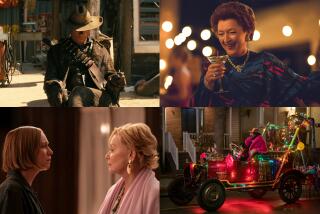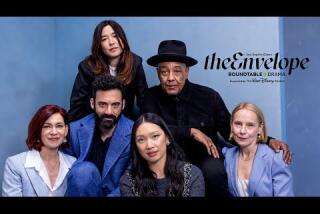The heart of a film often comes down to one key scene
It’s that signature moment in a movie. It’s the scene that brings all the dramatic elements together thematically or allows the story to unfurl organically. The Envelope spoke to several directors whose films span the globe from as far-off locales as India, Romania and West Texas, but they frankly admit that if these particular moments didn’t soar, their movies wouldn’t either.
So what scenes were key to the films?
Kenneth Lonergan, “Manchester by the Sea”
“The key scene is a flashback sequence, which happens about 40 minutes in. That’s the cornerstone of the whole movie. That said, there are many other scenes without which the film would collapse. If Lee didn’t have a happy marriage before this happened, there’s no story; if his brother hadn’t tried to take care of him, there would be less of a story. The story in its crudest terms is Lee’s been told to take care of his nephew but he can’t stay in the town. And once you take away one thing, everything else falls apart.”
Jeff Nichols, “Loving”
“I very much knew where I wanted to end the film, but there was really a question of what the climax was going to be. And it wasn’t until I found a quote from Mildred [Loving], shortly before she died, that I included at the end of the film, that said, “I miss him. He took care of me.” I was inspired by that to go back into the back third of the film and include a scene where Richard comes home from the bar after being challenged by a friend that he should just divorce her. And he comes home and tells Mildred that he can take care of her. And he repeats it over and over again. That really for me became the emotional climax of the whole film. You have a man telling his wife that he can take care of her at a point where we understand that that’s really not the case.”
Garth Davis, “Lion”
“Little Saroo [Sunny Pawar] trapped on that train had to be really powerful or we’d never have a second half of the movie. I decided we would make that the last scene we shot in India because I wanted him to have as much experience on set and build his confidence to that point. So, I never ever, ever wanted to do any trick performances with Sunny. I always wanted to do it ethically and responsibly. To get that performance a lot of it was literally that I would have to do it [myself]. I would show him how loud he had to scream. I would show him how to pull on the bars. I had to make him feel like it was OK and that anyone could do it. He loved the physicality. I got really lucky with him.”
Tom Ford, “Nocturnal Animals”
“It’s the scene of the abduction on the highway. You get six actors and they’re all, ‘No, if she were my daughter I would come over here and I would stand in-between.’ ‘Yeah, but if you did that then I would come over here and I would go over there.’ It was absolute mayhem so I finally just said, ‘Guys, you just all have to go away. Just go away.’ Then when we got there, set up the cars, blocked it out with them, we got it to a place where it felt natural for them. We also shot it handheld so it could be a lot looser, it’s meant to be visceral and raw and not so posed and so framed. It’s very long and it was the most complex to shoot. It’s 17½ minutes on screen.”
David Mackenzie, “Hell or High Water”
“The center of the film in all sorts of ways to me is the scene in which Marcus [Jeff Bridges] and Alberto [Gil Birmingham] are sitting on the porch outside the T-Bone cafe and Gil talks about how 150 years ago this was his people’s land. And there is a moment of resonance about the whole sort of narrative about the West being reclaimed by financial institutions and multinational corporations. There is that moment of insight talking about that and it sums up some of the themes of the film. And that kind of makes it a double porch scene with Toby [Chris Pine] and Tanner [Ben Foster] on their porch the last day before things kind of come to a head [coming immediately after]. It’s the heart and soul of the film. And you sort of feel the connection between both sets of characters that have taken different sides of the law, but effectively doing the same thing in the same sunset.”
Maren Ade, “Toni Erdmann”
“Sandra Hüller’s character singing Whitney Houston’s ‘The Greatest Love of All,’ which was an interesting shooting day. It was really hard to shoot that scene; we did that song eight times and it was very boring. So, we watched together and Sandra said, ‘It’s completely boring.’ And then I showed her this version she did during rehearsal. We called [that one] ‘Las Vegas.’ It was a very expressive version. And she said, ‘OK, I’m doing this Vegas thing now but I’m doing it only one time!’ The sound guy almost killed me because he was trying to get it recorded properly and it was so loud suddenly and so dramatic. I remember the woman who was doing the makeup was really crying.”
Mike Mills, “20th Century Women”
“It’s a sequence that starts with the boy [Lucas Jade Zumann] reading to his mom [Annette Bening] the essay ‘It Hurts to Be Alive and Obsolete’ by Zoe Moss. It’s from ‘The Sisterhood Is Powerful’ book that Greta Gerwig’s character gives him. It has a bunch of little elements that are kind of like the DNA of my favorite parts of my films. It’s this really kind of impossible attempt for this mother and son to understand each other across this particularly big generation gap. And the boy, the 15-year-old, is really trying to understand his middle-aged mother who was born in the ’20s who went through the Depression and WW II and is now a raising him in the ‘70s. It does nothing but unnerve her so it doesn’t work out, but I find it a really beautiful attempt from him to try and see her. Then there is a beautiful little montage of moments from her life and their life together while he’s reading.”
Rebecca Miller, “Maggie’s Plan”
“The very last scene of the movie — the one that had to work or the whole film would fail. We put the entire crew and most of the cast on ice. If Julianne Moore broke an arm, if the sun set before we were done, our goose was cooked. Just as the shadows grew long and the light changed, we came to the end of our shot list. The final close-up, of Greta Gerwig realizing at last that she is in love, was heartbreaking, and she was so lovely I could hardly bear it. And the minimal shots I had planned worked out, and the camera didn’t fall on the ice. Nothing bonds people like potential disaster. We now had the confidence to go on and make a film with a tough schedule.”
Theodore Melfi, “Hidden Figures”
“The scene between Octavia Spencer and Kirsten Dunst in the bathroom was key for me. For the first time in NASA’s history the bathrooms are desegregated and a black woman and a white woman are sharing a bathroom. Octavia says a line that sums up the whole film for me and about racism of the times. Kirsten says, “I know you don’t think I have anything against y’all” and Octavia says, “I know you don’t think that.” [Pointing out] the unconscious bias of then and today.”
See the most read stories this hour »
More to Read
From the Oscars to the Emmys.
Get the Envelope newsletter for exclusive awards season coverage, behind-the-scenes stories from the Envelope podcast and columnist Glenn Whipp’s must-read analysis.
You may occasionally receive promotional content from the Los Angeles Times.






